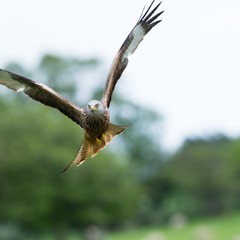
Soaraway success: Iolo on the great Welsh survivor
Look to the heavens almost anywhere in West Wales and there’s a very good chance that you’ll be treated to a breath-taking display of lazy, languid elegance.
Drifting across the skies with a graceful majesty unrivalled by any of our other feathered residents is the monarch of our skies – the red kite.
There is no sight more glorious on a summer afternoon than that of a red kite wheeling high across the wild blue yonder, rising on a thermal updraft, plummeting towards the earth or simply hanging effortlessly in air. Often full minutes pass without so much as the flap of a wing as these magnificent creatures twist, turn and soar using only minor adjustments of their instantly recognisable forked tail.
“The red kite is a truly magnificent bird,” said BBC presenter, naturalist and former RSPB Cymru officer, Iolo Williams. “Their aerial skills are simply breath-taking.”
With such dazzling displays –coupled with the red kite’s striking colouring and shape, it is little wonder that these monarchs of the skies have earned a place in the hearts of the nation.

“The red kite is Britain’s most iconic bird, but particularly here in Wales,” said Iolo. “They are incredibly beautiful and so agile and acrobatic. There is nothing else like them. They are amazing birds and seeing one is always a treat.”
Iolo can count himself fortunate – thanks to a career working alongside Welsh wildlife, he knows the red kite better than most, but his passion for the bird has never diminished.
“I have been working with red kites for nearly 40 years,” he said, “but I still get that buzz of excitement running through my veins every time I see one, even now.
“More than anything it is that iconic tail – that long, forked, rusty red tail, there is nothing else like it.”
That unique tail ensures that red kites – Milvus milvus – are easily identifiable, but they also stand out from the crowd thanks to their huge wingspan, distinctive markings and radiant colouring – their feathers glow a vibrant rusty red as the sunlight glances off their wings in flight.
But it is their agility in the air that makes them such a thrill to see. Their wingspan, which stretches almost six feet across, is around a foot wider than a buzzard, and makes them Wales’ largest common bird of prey.
“For such long-winged birds, they are incredibly acrobatic,” said Iolo. “Some of the displays I have seen them put on really do have to be seen to be believed.
“Despite its size, the red kite is actually a very light bird. Buzzards, although smaller, are much, much heavier in comparison. Red kites’ size is all down to their wings which are far larger in comparison to their bodies than with other birds of prey. This lightness means that they are incredibly acrobatic and able to manoeuvre themselves in flight in ways which seem impossible for a bird of their size.
“I have watched red kites play on the wing with tufts of grass and wool; soaring into the sky and dropping them then tucking in their wings and dropping like a bullet to catch them before they hit the floor. They are amazing to watch, it is nothing short of breath-taking.”
Adult birds can sometimes be seen teaching their young such daredevil feats with one parent flying in a wide protective perimeter while the second encourages the juvenile up to ever greater heights. Once high in the sky, they pull in their wings and drop like a stone, plummeting 50, 100, 200 feet at a time before spreading their wings in a stunning flash of red and gliding in a swooshing arc to safety before returning to the heavens to repeat the act, all the while encouraging their offspring to follow suit and fall further and faster each time.
“They have to be seen to be believed,” said Iolo. “When you see one that first time, it stays with you forever. There is absolutely nothing else like it.”
But while the red kite has become one of the emblems of Wales – so much so that it was crowned the nation’s favourite bird by the public in an RSPB Cymru/BBC Wales survey, it was not always so. It is thanks to the efforts of the likes of Iolo and his former RSPB colleagues, working alongside landowners and farmers, that the red kite is one of Wales’ greatest success stories.
Over the past few decades, residents and visitors in Carmarthenshire and inland Ceredigion have grown accustomed to seeing red kites overhead, and these stunning birds are now regularly seen throughout Pembrokeshire and the rest of Ceredigion – recent reports include sightings on Ramsay Island and over New Quay, but such sightings are the result of a stunning transformation in the fortunes of these birds. In fact, the survival and spread of red kites in Wales has been nothing short of miraculous, and their story is one the UK’s greatest conservation successes.
While they were common through the whole of the British Isles in medieval times and were even protected by a Royal Decree, they were to become the victims of the fake news of their day.
Although they are birds of prey and will, when necessary, catch small mammals such as mice, voles and young rabbits, red kites feed pre-dominantly on carrion – the flesh of already dead animals. It was because of this that they became regular guests in the town and cities of the Middle Ages where they were welcomed as a street-cleaning scavenger.
So common were they throughout the Medieval period that Geoffrey Chaucer’s Canterbury Tales refers to a kite carrying away bones in the Knight’s Tale; Shakespeare describes London as “the city of kites and crows” in Coriolanus. He also warns of kites stealing linen for nest-building in A Winter’s Tale while King Lear criticises his daughter Goneril as a “detested kite” – though why the kite deserves such abuse he doesn’t say, but then Lear is a madman so perhaps the insult shows how out of tune with reality he had become.
However, by the 1600s, the red kite had been falsely branded a livestock killer, with farmers, landowners and gamekeepers mistakenly believing that kites were responsible for attacking and killing their animals. In truth, the guilt invariably lay with more aggressive predators. But the damage was done and bounties were placed on red kites, with hunters actively encouraged to kill them.
For 200 years they suffered relentless persecution and their numbers were reduced to such an extent that by the 1800s their rarity had become so extreme such that they became the target of taxidermists and egg-hunters, desperate to add these disappearing birds to their collections before they vanished completely.
By 1870, the red kite was entirely extinct in England and Scotland, and little more than a century ago, there were believed to be just one or two pairs in the whole of the British Isles, hidden away in the Cambrian Mountains of Mid Wales.
However, with red kites all but eliminated from Britain, one of the very first conservation efforts in the world was initiated. In 1903 a formal programme was launched with the creation of the Kite Committee. The battle to save the red kite remains the longest continuous conversation programme in the world.
Despite such efforts, the RSPB believes that as many as a quarter of all eggs laid each year continued to be stolen by collectors – a trend that continued up until the 1950s and 60s, but thankfully, the tide began to turn in the red kite’s favour thanks to more sophisticated nest protection initiatives.
“It has been a remarkable story starting from the 1890s when there was just a handful of these incredible birds left,” said Iolo, “not just in Wales, but in the whole of Britain.
“Even when I joined the RSPB in the early 1980s there were still just 45 pairs or so scattered throughout mid Wales, they were scare still even then. But the experiences over the last 25 years or so has been truly remarkable.
“Over the past few years, red kites have been spotted on the Llyn peninsular in the north all the way down to the Gower on the south coast. There have even been sightings of red kites on Anglesey and we know of at least dozen and perhaps as many as 20 pairs now nesting in Pembrokeshire. It really is a fantastic situation – especially when you consider where we were just a few years ago.
“We have gone from there being just a few birds confined to central Wales 40 years ago to them being all over Wales today. It is incredible.”
“I am really proud of the fact that the success of the red kite has been due to a national effort and to everyone working together. It is down to the fact that so many landowners and wildlife officers in Wales and across Britain have worked together and brought this bird back from the brink.
“It is one of the most successful conservation efforts in history, particularly in Britain. It is certainly up there with the very best conservation efforts anywhere in the world. And to have a story like this here in Wales when we hear about so much bad news about the natural world and when we hear of so many species being pushed to the brink of extinction and beyond, a story like this is nothing short of beautiful.”
Having battled back from the very edge of extinction to become our most treasured bird is testament to the remarkable staying power of the red kite. The success of the conservation effort is something of which we should all be incredibly proud, but even more special than the knowledge that Wales has played a key role in their survival is the fact that wherever we might be in West Wales we are sharing our landscape with these magnificent monarchs of the sky.
That we have the opportunity to see them on almost any day is something for which we should all be grateful – and if you haven’t seen one yet, keep looking up because when you do, you’ll never forget it.
“It does not matter where you live in Wales, get out and get walking and keep looking skyward,” said Iolo. “Even though you might live in an area where red kites do not breed, there’s no reason why you cannot see them. Red kites, particularly young birds, are known to cover huge distances and when you do see one it stays with you forever. There is absolutely nothing else like it.”


